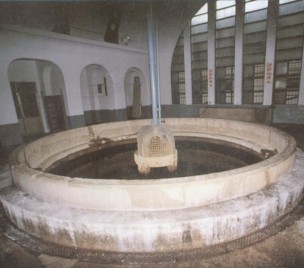 Taiwan Railway Administration Taipei Railyard Bathhouse
Taiwan Railway Administration Taipei Railyard Bathhouse Construction of Taiwan's first railway began during the administration of Qing dynasty governor Liu Ming-chuan in the late 19th century. During the era of Japanese rule, colonial government engineer Hayami Kazuhiko designed the New Taipei Railway Production Yard. With 39 buildings occupying 19 hectares, it was the largest railway production yard of East Asia. Steam traveled through pipes from the factory boiler into the bathhouse pool, where employees could wash before going home. The bathhouse is an important artifact of Taiwan's labor history.
Design of the public bathhouse was influenced by Japanese Secession architecture, with a highly geometrical exterior design. The building is made of reinforced concrete with steel beams, with a shell-like dome on its roof. The semi-cylindrical interior space is free of support columns, and windows on both left and right sides allow sunlight in, creating a lofty and bright atmosphere.
Located on 19 hectares of land, the Songshan Tobacco Plant, at one time the largest factory in East Asia, is representative of Taiwan's industrial architecture during the era of Japanese rule (1895-1945). Following World War II, it came under the management of the Taiwan Tobacco & Wine Monopoly Bureau, ceasing operation in 1998. Over the course of its history the plant produced 46 different brands of tobacco products, playing a significant role in Taipei's industrial history.
Surrounded by pleasant gardens, the plant featured a complete spectrum of facilities, from offices to production areas, boiler rooms and storage areas, arranged according to a logical production flow plan. Raw materials and finished products were transported in and out of the factory by rail, the vestiges of which can still be seen today. The Songshan Tobacco Plant also had a nursing room, a clinic and a cafeteria for the workers. Security control rooms and defensive fortifications safeguarded the bureau's monopoly powers.

![Taiwan.gov.tw [ open a new window]](/images/egov.png)
